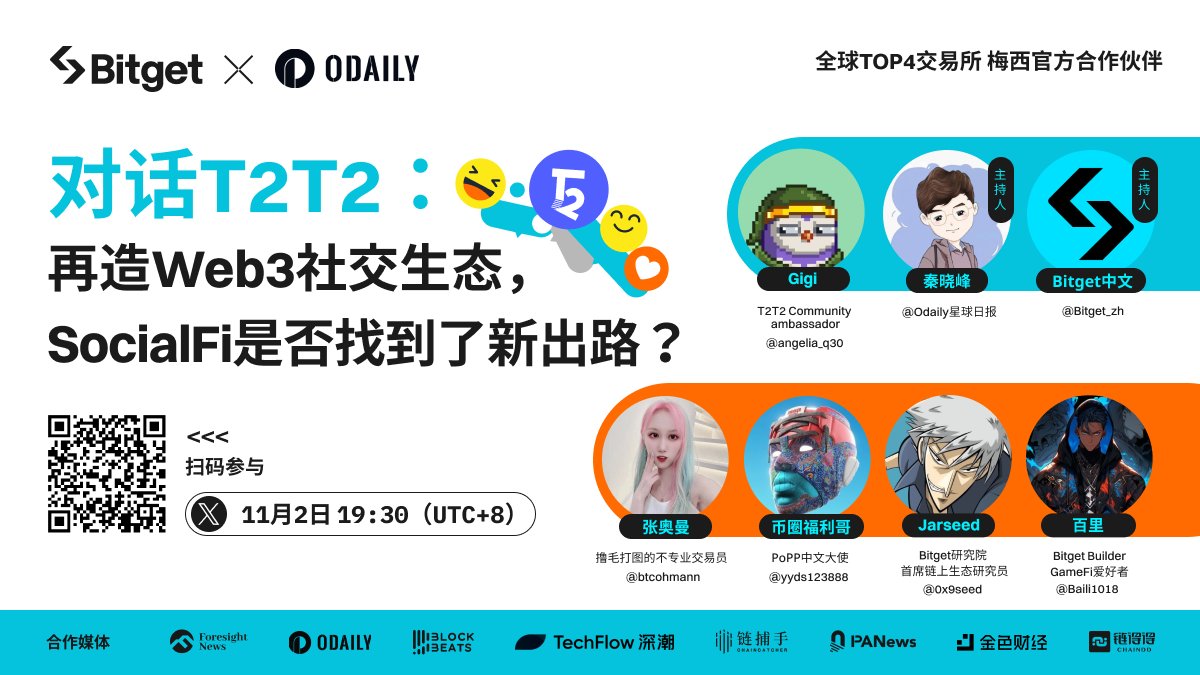对话T2T2:再造Web3社交生态,SocialFi是否找到了新出路?
近日,Odaily星球日报联合 Bitget,举办了以Web3社交生态为主题的 X Space,共同探讨 SocialFi 的新出路。参与嘉宾包括T2T2社区大使 GiGi、 Bitget 研究院首席链上生态研究员 Jarseed、KOL 张奥曼、PoPP 中文大使币圈福利哥及来自百里社区的百里。
T2T2 是一个部署在 Ethereum 和 Base 链上的综合性 Web3 社交服务平台,专注于创新的链上社交互动。其目的是为 Web3 领域的所有用户提供一站式社交服务。通过 T2T2,用户、项目团队和 KOL 可以轻松参与社交互动,实现个人经济价值的最大化。

以下为社区对话实录:
Odaily星球日报:大家晚上好,今天晚上星球日报邀请到了来自社交服务平台T2T2、交易平台、社区等不同领域的嘉宾,大家一起来聊一聊 SocialFi 赛道的未来发展趋势。首先是今天的第一个问题。SocialFi 赛道是否有可能会跑出一些Web3超级应用?
Jarseed:针对金融和游戏而言,金融涉及众多规则和工具,学习成本相对较高。对于大多数用户来说,需要经历学习阶段。使用不当还可能会导致亏损。金融的门槛和学习成本相对较高,这自然而然地将一些用户拒之门外。而游戏拥有更广泛的受众。
当游戏进入区块链领域,我们会看到更多的结合了金融元素。游戏包括一些以赚取利润为目的的玩法,这与我们之前熟悉的一些知名游戏有所不同。各式 X 2 earn 产品的玩家大多以盈利为主要目标参与,而很少有能够创造如魔兽世界等互联网时代的游戏超级 IP。
因此,GameFi 虽然吸引了更多参与用户,但其持续的盈利能力和长期运营能力相对有限,我们看到的 IP 数量也相对较少。
与金融相比,社交的门槛较低,任何人都可以轻松参与其中。相对于游戏,社交可以创造更大的社交圈子。在社交系统内,任何人都可以互相连接,不仅仅是因为某些其他原因,粉丝和个人之间可以建立联系,你也可以在其中找到更多志同道合的人。这些联系不可避免地需要一些工具来建立和维护。
因此,Web3 在社交领域提供了一个良好的空间来建立工具和应用。因此,我认为在社交领域中,Web3 超级应用更容易出现。
GiGi:SocialFi 赛道最近一直备受瞩目,特别是自 Friend tech 崭露头角以来,这个领域的热度一直持续上升。我认为 SocialFi 在我们日常生活中是非常必要的,它本身具有强大的社交关系因素,因此它的发展势不可挡。
从 Friend tech 这个概念开始,以及众多相关仿盘的出现,都证明了这个“Fi”的存在是不可或缺的,并且它具有巨大的潜力。然而,除了 Friend tech 之外,这一领域还有许多其他方向值得深入探讨。因此,在 SocialFi 赛道,我们将看到更多类似 Friend tech 的超级项目的涌现,包括像我们T2T2这样的项目,我们正在进行创新,引入了一种明确的任务。稍后我将介绍我们的创新点。我认为我们的产品是很成熟并且体系化的,也欢迎大家来体验。
百里:谈一下我对超级应用的理解——拥有庞大的用户群体、日活高、具有赚钱效应、TVL 足够大,超级应用可以引起社区的广泛讨论。诚然,超级应用可能大多数会包含社交,但我认为超级应用的诞生似乎跟赛道的关系不是特别大。主要是看产品本身是否有足够的赚钱效应和创新玩法,以及未来破圈的可能性。
张奥曼:我认为社交领域下跑出 Web3超级应用是有一定阻力的。但是一旦做好的话也可以发展的更长久。
我们现在面临的一个问题就是,微信上的限制比较多,用户更期待有一个属于我们的社交平台。但是我觉得做好社交领域,首先就是说抓住流量入口,不仅仅是说去获取流量,更重要的是让流量能存活下来、稳定下来。Friend tech 最初的流量很好,但随着各种仿盘的出现,真正留存下来的流量并不多,Friend tech 的用户体验不好。怎么能让用户留下来,对 SocialFi 来说是一个至关重要的问题。
币圈福利哥:社交是无处不在的,每个人都有社交需求。无论是在寻找伴侣结婚、在学校寻找朋友、在工作中与同事互动,还是在Web3中寻找志同道合的人,社交一直是必不可少的。在任何领域,社交都是一个先决条件。无论是T2T2还是 Friend tech 等。
有许多人希望参与龙头项目,但要明白,当一个项目在社交领域取得巨大成功时,就像比特币和以太坊一样,无论是龙头、龙二还是龙三项目,都有机会在该领域创造自己的成就。目前,T2T2具有成为龙二项目的潜力,因为它有很多有力的支持和投资方式,我认为它有成为龙二项目的潜力。它之所以能够崭露头角,正如我之前提到的,是因为社交是必不可少的,而且它的用户界面设计非常出色。
T2T2和 Friend tech ,我更愿将它们类比为比特币和以太坊。T2T2相对于 Friend tech 更加接地气,我们更清楚地了解它,知道背后的投资者是谁,了解我们使用的应用程序的来源。最近你可能也注意到了T2T2的声音越来越高,一些知名人士也开始推动。因此,我认为T2T2有望轻松崭露头角。社交领域也是一个非常容易崭露头角的领域,正如我之前所说,有人的地方就需要社交。因此,我个人非常看好T2T2。
Odaily星球日报:第二个问题则关于基础性能方面。我们经常听到有人说以太坊可能不太适合一些如游戏之类的高频交互的应用。
各位嘉宾如何看待这个问题?像 SocialFi 这样的应用是否需要一个专用的协议层?还是可以基于现有的通用底层来构建应用?
Jarseed:因为我们现在看到越来越多的应用,它将Web2和Web3的技术结合在一起。实际上,除了完全基于区块链的交易可能对整个供应链的 TPS 要求较高之外,其他一些场景下,一些功能可能在Web2端就能够满足,并且更好地为用户提供服务。
有些功能可能只需要在链上进行确认和所有权归属的处理。因此,我认为这个问题可以有两种解决方案,两者都可以提供很好的解决方案。
我们可以看到,Friend tech 的出现并不是依赖于更高频的交互场景或对更高性能的要求,而是通过设置一个巧妙的机制让大家都能参与其中。我相信T2T2的设计和产品交付情况也能够做得非常好,而不一定需要依赖于专有的供应链或协议层来满足某些场景的需求,我认为这是可行的。
GiGi:在以太坊上,对于普通用户来说,成本确实相对较高。大家也注意到了T2T2最初起源于 Base 链,它成功降低了用户参与的成本。实际上,我们的新功能会根据需求在以太坊链上推出,但并没有完全依赖于以太坊这样的底层链,而是在一定程度上降低了用户的交互成本。
T2T2本身并没有增加扩大影响力或社交成本,而是提升了后续操作的可能性。例如,我们即将推出的新功能,如跟单交易,将在以太坊上实现,这将刺激用户的兴趣,产生相似的效果。
从T2T2的角度出发,以太坊只是一个选择,但不一定是唯一的选择。我们需要从成本和效益的角度考虑,从用户和项目方的角度综合考虑。最终,我们将T2T2建立在 Base 链和以太坊上。
我们认为,随着 KOL 的加入,他们的影响力将激励发展,因为我们提到的跟单功能和激励用户交易的独特方式将被用于推广。T2T2在T2T2链和以太坊上建立,并不绝对依赖于以太坊,而我们的生态系统也在良好发展。
张奥曼:我个人认为,基于现有的通用底层技术来开发应用类产品是可行的。因为对于一款成功的产品来说,最重要的是让大多数用户使用起来感到舒适。
就像现在的 GameFi,即使我是一个网瘾少女,但仍很少玩。因为玩起来不好玩,我还需要花钱,也不一定能赚钱。很多时候,一款应用程序并不需要过于复杂,关键是要让用户感到使用习惯,这才是核心。就像最初的腾讯一样,首先做好基本功能,吸引用户,然后再完善一些特殊功能。
币圈福利哥:我认为目前的T2T2,包括你提到的这些应用,已经相当完善了。然而,我认为有待改进的一个方面是排名和排行榜。
Friend tech 能成功的一个原因是,参与的大 V 们在 FT 上很有“面子”。他们在 FT 上的排名高、分到的代币多,他们愿意玩 FT。就目前来看,T2T2对排名靠前的人的激励和竞争刺激方面都不够充分。
当你的创意特别出色时,技术只是一个辅助作用,不能起到决定性的作用。因此,我认为最重要的是激励政策。就像我刚才提到的,为什么要玩这种 SocialFi?因为它增加了我的面子。如何让大 V 们既赚到面子又赚到钱,这才是值得考虑的问题。
百里:专注于产品本身,能够为用户和玩家提供更多收益和更好的体验,可能比专门的功能协议层更切实可行。
现在已经有足够多的公共链和协议,可以满足社交产品的需求。我们可以回顾一些功能链的情况,如游戏链的 IMX、NFT 链 Flow、存储链 FIL 等。时至今日,它们正在寻求扩展生态的可能性,专用性反而抑制了自身的发展。因此,我认为专注于应用本身可能会更好。
Odaily星球日报:我们刚刚也聊了T2T2,那么可能对于一些我们知道可能现在市场上有很多 friend 的其他的后进者也好,或者说竞品也罢,然后对于这些其他的一些产品来说,他们会有哪些弯道超车的机会?
Jarseed:在Web3的发展过程中,我们经历了许多类似 Ponzi 的模式,以及前期难以正确估值Web3产品的情况。早期我们都在创造新概念,打破传统认知,缺乏对其进行定价的客观方式。
然而,现在整体经济环境相对紧张,市场对创业赛道和项目的估值更为保守。在这种环境下,我们更加看重项目或企业的现金流健康状况。我认为T2T2的设计非常有趣,T2T2引入了飞轮模式,即 KOL、购买 KOL 的人以及平台的收入之间相互补贴,这有助于促进生态的持续发展。
T2T2将收入与代币持有者、以及 KOL 进行分配,这种模式实际上是一种有机的成长模式。尽管一开始可能进展不会很快,但随着时间的推移,所有代币持有者都共享了平台的增长。我认为这是一种非常出色的模式。
同时,社交领域将继续受到关注,如果t2t2能在这个领域取得领先地位,并让所有代币持有者分享平台的增长,那么这不仅在产品和体验方面,更在收入方面可能是一种出色的超越方式。
GiGi:从 friend tech 之后,SocialFi 的热情又持续提高。在社交上,特别是在传统的社交领域,大家都会去关注自己的隐私问题,所以说在基于 SocialFi 还有一些隐私上可以做一些探讨,比如说运用 ZK 技术等。
币圈福利哥:弯道超车本身是一个伪命题,就像苹果手机一样,一直被模仿,从未被超越。后面只能形成一定的诸侯割据。我们刚刚说T2T2的背景很强大,它也能做起来。但要超越 FT 还需努力。毕竟 ETH 也一直在试图超越 BTC 对不对。
Odaily星球日报:T2T2本身在 SocialFi 的社交赛道中定位是什么?未来可能会有哪些重要的规划?
GiGi:社交与金融的结合有着广阔的想象空间。在区块链领域,金融问题通常是关乎赚钱的,因此将社交与金融相结合提供了巨大的潜力。特别是在 Web3 领域,我认为有几个潜在的应用方向。
去中心化社交支付。这种方式可以让用户直接进行点对点支付或转账,而无需依赖传统金融机构,避免了许多问题。
社交投资网络。用户可以分享他们的投资组合和策略,甚至合作投资项目,建立自己的声誉。其他用户可以看到这些信息并信任他们,从而分享投资效益。
社交借贷。这种模式可以允许用户通过社交担保来建立信用,从而借款。还可以设定时间限制来降低风险,以防止贷款平台出现问题。
另一个潜在的应用领域是社交游戏。当前,GameFi 领域非常热门,特别是一些公会战斗游戏,玩家一起策划如何进攻等。将社交游戏与金融结合,让用户能够在游戏内直接交易虚拟资产和货币,而无需将它们提取到链上。这样的设计不仅方便,还能防止游戏停服的情况。
社交身份验证也是一个重要领域。用户可以使用社交网络中的身份信息构建去中心化身份验证系统,用于金融服务和实名认证产品。
这些应用可能主要面向企业用户,但也包括互助、社交互助、金融服务、小额借贷以及捐赠等产品,都有可能涌现。这些方向都具有创新点,但实际执行可能需要克服一些挑战。



